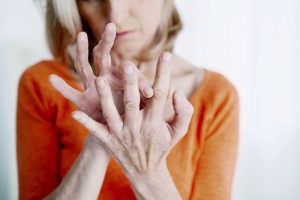 When we hear the word “arthritis,” it is common to think about the breakdown of joints that happens naturally with age. Despite the fact that both conditions are a form of arthritis – inflammation and breakdown at a joint – there are some very distinct differences between the two.
When we hear the word “arthritis,” it is common to think about the breakdown of joints that happens naturally with age. Despite the fact that both conditions are a form of arthritis – inflammation and breakdown at a joint – there are some very distinct differences between the two.
Osteoarthritis
Osteoarthritis is a condition that occurs when the cartilage in joints deteriorates over time, causing inflammation in the joint secondary to bone moving on bone. As the cushioning from the cartilage at the ends of bones deteriorates, the ends of bones become closer together, causing a decrease in joint space and often a great amount of pain.
When this happens, range of motion may be lost as there is no longer an ample amount of space for movement to occur at the joint itself. This is a condition that is caused by a number of factors but is not entirely inevitable.
Symptoms
- Pain at the joint
- Joint tenderness
- Joint stiffness
- Joint range of motion restriction
- Sensation of “bone on bone”
- Bone spurs
Risk Factors
1. Age is a major factor for developing osteoarthritis. As the body ages, the impacts from years of physical activity and movement start to break down the cartilage in our joints, especially at the knees, back, and shoulders. This is especially influenced by a number of lifestyle factors and in part by genetics.
2. Joint injuries, such as a torn meniscus, can predispose someone to develop osteoarthritis later in life. Any time there is a significant injury to the joint, the cartilage may be compromised, whether minimally or to a large degree. This cartilage damage speeds up the natural decay of the body’s natural joint cushioning, potentially causing the onset of osteoarthritis earlier in life.
3. Gender may also play a factor as women have been shown to develop osteoarthritis at higher rates than men. While the reason is not clearly understood, it is known that women will often have a lower degree of bone health than men and it is suspected that this may prove to be true for cartilage as well.
4. Occupation is an important factor to consider. When individuals perform labor-intensive work for the majority of their working life, a lot of additional stress will be placed on their joints and in turn on the cartilage. It is common to see an early onset of osteoarthritis in laborers such as construction workers and carpenters.
5. Genetics is a less discussed but very relevant factor that predisposes one to osteoarthritis. Bone structure and angle of articulation may differ from person to person, causing more stress on certain aspects of the cartilage. This is very common in people deemed to be “knock knee’d” as a great amount of stress is placed on the cartilage at the medial joint line since the space between to bones is deceased. These individuals are more susceptible to develop osteoarthritis in their knees early in life, with the rest of the joint following suit in the years that follow.
Rheumatoid Arthritis
Rheumatoid arthritis, as opposed to osteoarthritis, is an autoimmune disorder that occurs when the immune system attacks the synovium of joints. While there are certain risk factors that increase the chances of this condition occurring, it is normally one that will manifest without any general warning in middle-aged individuals.
When the immune system starts attacking the joints, a great deal of pain may be experienced as functions start to decrease.
Symptoms
- Joint tenderness
- Joint swelling
- Joint warmth
- Joint stiffness that is worse in the mornings and after periods of inactivity
- Fatigue
- Fever
- Loss of appetite
Risk Factors
1. Age can be a slight factor as this condition will usually manifest in middle-aged individuals. However, unlike osteoarthritis, life exposures do not generally increase risk.
2. Smoking, especially in those with a family history of rheumatoid arthritis, has been shown to cause an earlier manifestation of signs and symptoms than would otherwise normally occur.
3. Obesity, especially in those with a family history of rheumatoid arthritis, has been shown to have a higher association with signs and symptoms of rheumatoid arthritis. This is especially true for women under 55 who are obese.
Key Takeaway
While both forms of arthritis are prevalent among the American population, they do have different causes and clinical presentations. While prevention is not altogether very possible, especially for rheumatoid arthritis, living a healthy and active lifestyle may help reduce your risks.
If you start to have symptoms of joint stiffness, pain, loss of range of motion, or any other symptoms listed above, you should contact your physician immediately. With 17 expert and compassionate providers, South Shore Orthopaedics is committed to ensuring that you receive treatment of the highest caliber using the latest proven techniques. To schedule an appointment, call (781) 337-5555.
